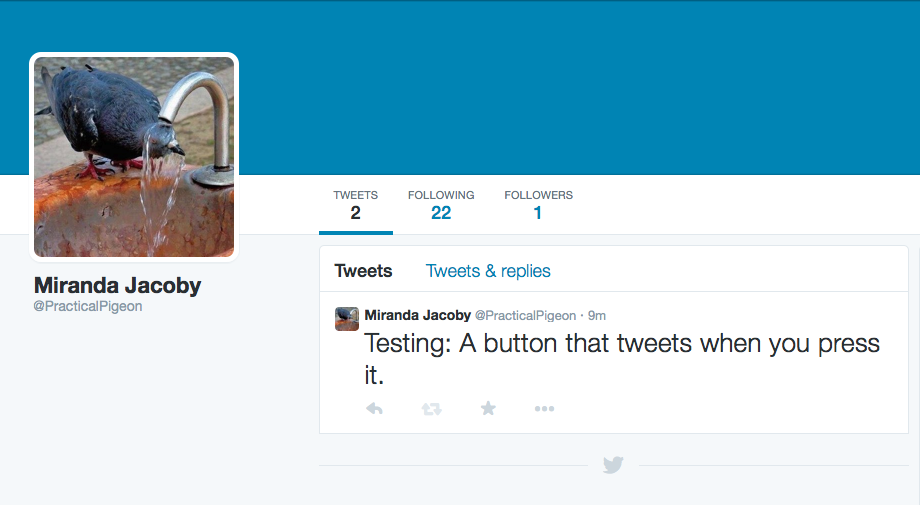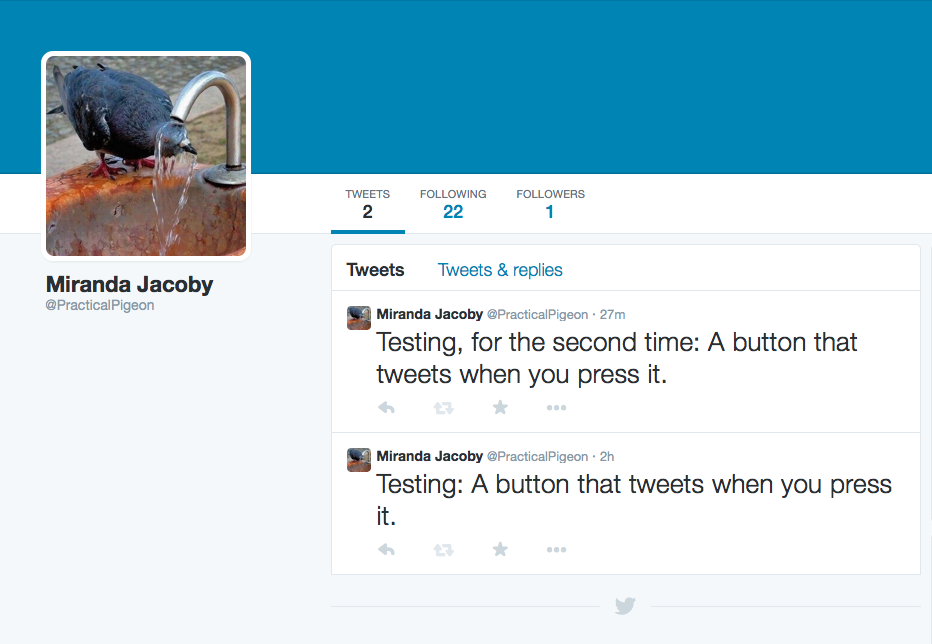A Button that Tweets
Full disclosure: I went for the minimal project so that I can dedicate more time to the final.
 This is my initial Temboo test, before the button was connected.
This is my initial Temboo test, before the button was connected.
 This test has the button connection. Now we have a tweeting button!
This test has the button connection. Now we have a tweeting button!
//Miranda Jacoby
//Electronic Media Studio Interactivity Section A
//majacoby@andrew@.cmu.edu
//Copyright Miranda Jacoby 2014
//Code created with help of Golan Levin
//With elements of the pushbutton example code
//created 2005
//by DojoDave <http://www.0j0.org>
//modified 30 Aug 2011
//by Tom Igoe
//http://www.arduino.cc/en/Tutorial/Button
// constants won't change. They're used here to
// set pin numbers:
const int buttonPin = 2; // the number of the pushbutton pin
// variables will change:
int buttonState = 0; // variable for reading the pushbutton status
void setup() {
Serial.begin(9600); // initialize serial communications
}
void loop(){
// read the state of the pushbutton value:
buttonState = digitalRead (buttonPin);
// print if the pushbutton is pressed.
// Serial.println (buttonState); writes the string "1" or "0"
Serial.print (buttonState);
delay (10); // wait some number of milliseconds
}
//Miranda Jacoby
//Electronic Media Studio Interactivity Section A
//majacoby@andrew@.cmu.edu
//Copyright Miranda Jacoby 2014
//Code created with help of Golan Levin and Temboo.
import com.temboo.core.*;
import com.temboo.Library.Twitter.Tweets.*;
import processing.serial.*;
Serial myPort; // Create object from Serial class
int currVal; // Data received from the serial port
int prevVal;
int tweetTime;
int currentTime;
// Create a session using your Temboo account application details
TembooSession session = new TembooSession("pigeon", "pigeontwitter", "2289511ed75e4578a3b71a4b693fdb03");
void setup() {
size(200, 200);
String portName = Serial.list()[5];
myPort = new Serial(this, portName, 9600);
currentTime = millis();
}
void draw() {
prevVal = currVal; // swap
if ( myPort.available() > 0) { // If data is available,
currVal = myPort.read(); // read it and store it in val
myPort.clear();
}
background(255); // Set background to white
if (currVal == 48) { // If the serial value is "0",
fill(0); // set fill to black
} else if (currVal == 49) { // If the serial value is not 0,
fill(240); // set fill to whiteish
} else {
fill(255, 0, 0);
}
rect(50, 50, 100, 100);
if (currVal != prevVal) {
if (currVal == 48) {
sendTweet();
} else if (currVal == 49) {
// println ("Released!");
}
}
}
void sendTweet(){
tweetTime = millis() - currentTime;
println ("I was pressed at " + tweetTime);
if (tweetTime > 1000){
println("Sucessful tweet");
//send tweet by running the StatusesUpdate Choreo function
runStatusesUpdateChoreo();
}
else {
println("To soon to tweet!");
}
currentTime = millis();
}
void runStatusesUpdateChoreo() {
// Create the Choreo object using your Temboo session
StatusesUpdate statusesUpdateChoreo = new StatusesUpdate(session);
// Set credential
statusesUpdateChoreo.setCredential("TweetButton");
// Set inputs
statusesUpdateChoreo.setAccessToken("2769267476-rHudd8EwU7uLhkcruAwHxJtzA5AB7EH9lwPFD7s");
statusesUpdateChoreo.setAccessTokenSecret("aIxNctSi3RXShSRn0iWfaDkE8NSN9OglhY4GgOU1gWRZy");
statusesUpdateChoreo.setStatusUpdate("Testing, for the second time: A button that tweets when you press it.");
// Run the Choreo and store the results
StatusesUpdateResultSet statusesUpdateResults = statusesUpdateChoreo.run();
// Print results
println(statusesUpdateResults.getResponse());
}

